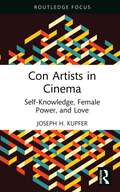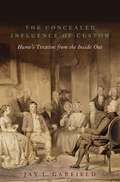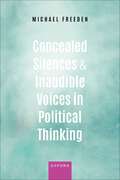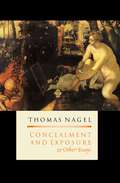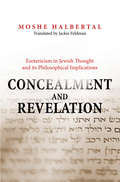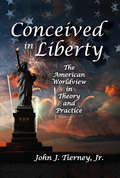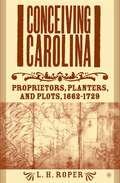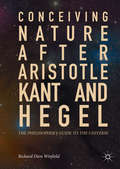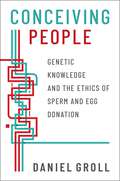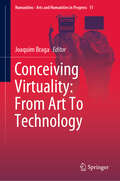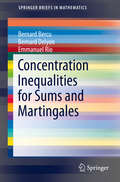- Table View
- List View
Con Artists in Cinema: Self-Knowledge, Female Power, and Love (Routledge Focus on Film Studies)
by Joseph H. KupferThis book examines the con artist film as a genre, exploring its main features while also addressing variations within it. The volume explores three diverse themes of the con artist film: edification, self-awareness, and liberation through con games; the femme fatale as con artist; and romantic love as a plot point. Analyzing movies such as Matchstick Men (2003), House of Games (1987), Body Heat (1981), The Last Seduction (1994), Birthday Girl (2001), and The Game (1997), the book also explores their psychological investigation of the con artist figure, the con artist’s mark, and how the dynamic between these roles implicates us as the audience. It also addresses the con artist film genre’s close association with neo-noir, especially through the femme fatale figure, investigating and updating the rich tradition of noir film. Demonstrating the range and flexibility of this understudied genre, this book will be of interest to scholars and students of film studies, ethics, and those studying the representation of women in film..
The Concealed Influence of Custom: Hume's Treatise from the Inside Out
by Jay L. GarfieldJay L. Garfield defends two exegetical theses regarding Hume's Treatise on Human Nature. The first is that Book II is the theoretical foundation of the Treatise. Second, Garfield argues that we cannot understand Hume's project without an appreciation of his own understanding of custom, and in particular, without an appreciation of the grounding of his thought about custom in the legal theory and debates of his time. Custom is the source of Hume's thoughts about normativity, not only in ethics and in political theory, but also in epistemological, linguistics, and scientific practice- and is the source of his insight that our psychological and social natures are so inextricably linked. The centrality of custom and the link between the psychological and the social are closely connected, which is why Garfield begins with Book II. There are four interpretative perspectives at work in this volume: one is a naturalistic skeptical interpretation of Hume's Treatise; a second is the foregrounding of Book II of the Treatise as foundational for Books I and III. A third is the consideration of the Treatise in relation to Hume's philosophical antecedents (particularly Sextus, Bayle, Hutcheson, Shaftesbury, and Mandeville), as well as eighteenth century debates about the status of customary law, with one eye on its sequellae in the work of Kant, the later Wittgenstein, and in contemporary cognitive science. The fourth is the Buddhist tradition in which many of the ideas Hume develops are anticipated and articulated in somewhat different ways. Garfield presents Hume as a naturalist, a skeptic and as, above all, a communitarian. In offering this interpretation, he provides an understanding of the text as a whole in the context of the literature to which it responded, and in the context of the literature it inspired.
CONCEALED INFLUENCE OF CUSTOM C: Hume's Treatise from the Inside Out
by Jay L. GarfieldJay L. Garfield defends two exegetical theses regarding Hume's Treatise on Human Nature. The first is that Book II is the theoretical foundation of the Treatise. Second, Garfield argues that we cannot understand Hume's project without an appreciation of his own understanding of custom, and in particular, without an appreciation of the grounding of his thought about custom in the legal theory and debates of his time. Custom is the source of Hume's thoughts about normativity, not only in ethics and in political theory, but also in epistemological, linguistics, and scientific practice- and is the source of his insight that our psychological and social natures are so inextricably linked. The centrality of custom and the link between the psychological and the social are closely connected, which is why Garfield begins with Book II. There are four interpretative perspectives at work in this volume: one is a naturalistic skeptical interpretation of Hume's Treatise; a second is the foregrounding of Book II of the Treatise as foundational for Books I and III. A third is the consideration of the Treatise in relation to Hume's philosophical antecedents (particularly Sextus, Bayle, Hutcheson, Shaftesbury, and Mandeville), as well as eighteenth century debates about the status of customary law, with one eye on its sequellae in the work of Kant, the later Wittgenstein, and in contemporary cognitive science. The fourth is the Buddhist tradition in which many of the ideas Hume develops are anticipated and articulated in somewhat different ways. Garfield presents Hume as a naturalist, a skeptic and as, above all, a communitarian. In offering this interpretation, he provides an understanding of the text as a whole in the context of the literature to which it responded, and in the context of the literature it inspired.
Concealed Silences and Inaudible Voices in Political Thinking
by Michael FreedenConcealed Silences and Inaudible Voices in Political Thinking investigates silence as a normal, ubiquitous, and indispensable element of political thinking, theory, and language. It explores the diverse dimensions in which silences mould the different core features of the political, as a highly flexible power resource, both enabling and constraining major social practices, traditions, and currents. Departing from the typical focus on intentional silencing and the dominance of logos, the book instead highlights the concealed and unrecognized ways through which silence pervades socio-political life and adopts the guises of the unspeakable, the ineffable, the inarticulable, and the unconceptualizable. Drawing extensively from historical, philosophical, anthropological, psychoanalytical, theological, linguistic, and literary viewpoints, the book demonstrates the common threads that connect silences to those different disciplines, alongside the features that pull them asunder. In extracting and decoding their political implications, it explores both academic literature and colloquial, everyday discourse. Michael Freeden uses select case-studies to explore topics such as Buddhist nondualism, Locke's tacit consent, the submerging of historical narratives, state neutrality, Pinter's miscommunications and menace, and the separate ways ideologies integrate silence into their beliefs. The book offers an analysis of silence from a multi-perspectival range of disciplines, providing a comprehensive and holistic view of silence and the political.
Concealed Silences and Inaudible Voices in Political Thinking
by Michael FreedenConcealed Silences and Inaudible Voices in Political Thinking investigates silence as a normal, ubiquitous, and indispensable element of political thinking, theory, and language. It explores the diverse dimensions in which silences mould the different core features of the political, as a highly flexible power resource, both enabling and constraining major social practices, traditions, and currents. Departing from the typical focus on intentional silencing and the dominance of logos, the book instead highlights the concealed and unrecognized ways through which silence pervades socio-political life and adopts the guises of the unspeakable, the ineffable, the inarticulable, and the unconceptualizable. Drawing extensively from historical, philosophical, anthropological, psychoanalytical, theological, linguistic, and literary viewpoints, the book demonstrates the common threads that connect silences to those different disciplines, alongside the features that pull them asunder. In extracting and decoding their political implications, it explores both academic literature and colloquial, everyday discourse. Michael Freeden uses select case-studies to explore topics such as Buddhist nondualism, Locke's tacit consent, the submerging of historical narratives, state neutrality, Pinter's miscommunications and menace, and the separate ways ideologies integrate silence into their beliefs. The book offers an analysis of silence from a multi-perspectival range of disciplines, providing a comprehensive and holistic view of silence and the political.
Concealment and Exposure: And Other Essays
by Thomas NagelThomas Nagel is widely recognized as one of the top American philosophers working today. Reflecting the diversity of his many philosophical preoccupations, this volume is a collection of his most recent critical essays and reviews. The first section, Public and Private, focuses on the notion of privacy in the context of social and political issues, such as the impeachment of President Clinton. The second section, Right and Wrong, discusses moral, political and legal theory, and includes pieces on John Rawls, G.A. Cohen, and T.M. Scanlon, among others. The final section, Mind and Reality, features discussions of Richard Rorty, Donald Davidson, and the Sokal hoax, and closes with a substantial new essay on the mind-body problem. Written with characteristic rigor, these pieces reveal the intellectual passion underlying the incisive analysis for which Nagel is known.
Concealment and Revelation: Esotericism in Jewish Thought and its Philosophical Implications
by Moshe Halbertal Jackie FeldmanDuring the twelfth and thirteenth centuries, great new trends of Jewish thought emerged whose widely varied representatives--Kabbalists, philosophers, and astrologers--each claimed that their particular understanding revealed the actual secret of the Torah. They presented their own readings in a coded fashion that has come to be regarded by many as the very essence of esotericism. Concealment and Revelation takes us on a fascinating journey to the depths of the esoteric imagination. Carefully tracing the rise of esotericism and its function in medieval Jewish thought, Moshe Halbertal's richly detailed historical and cultural analysis gradually builds conceptual-philosophical force to culminate in a masterful phenomenological taxonomy of esotericism and its paradoxes. Among the questions addressed: What are the internal justifications that esoteric traditions provide for their own existence, especially in the Jewish world, in which the spread of knowledge was of great importance? How do esoteric teachings coexist with the revealed tradition, and what is the relationship between the various esoteric teachings that compete with that revealed tradition? Halbertal concludes that, through the medium of the concealed, Jewish thinkers integrated into the heart of the Jewish tradition diverse cultural influences such as Aristotelianism, Neoplatonism, and Hermeticisims. And the creation of an added concealed layer, unregulated and open-ended, became the source of the most daring and radical interpretations of the tradition.
Concealment and Revelation: Esotericism in Jewish Thought and its Philosophical Implications (PDF)
by Moshe Halbertal Jackie FeldmanDuring the twelfth and thirteenth centuries, great new trends of Jewish thought emerged whose widely varied representatives--Kabbalists, philosophers, and astrologers--each claimed that their particular understanding revealed the actual secret of the Torah. They presented their own readings in a coded fashion that has come to be regarded by many as the very essence of esotericism. Concealment and Revelation takes us on a fascinating journey to the depths of the esoteric imagination. Carefully tracing the rise of esotericism and its function in medieval Jewish thought, Moshe Halbertal's richly detailed historical and cultural analysis gradually builds conceptual-philosophical force to culminate in a masterful phenomenological taxonomy of esotericism and its paradoxes. Among the questions addressed: What are the internal justifications that esoteric traditions provide for their own existence, especially in the Jewish world, in which the spread of knowledge was of great importance? How do esoteric teachings coexist with the revealed tradition, and what is the relationship between the various esoteric teachings that compete with that revealed tradition? Halbertal concludes that, through the medium of the concealed, Jewish thinkers integrated into the heart of the Jewish tradition diverse cultural influences such as Aristotelianism, Neoplatonism, and Hermeticisims. And the creation of an added concealed layer, unregulated and open-ended, became the source of the most daring and radical interpretations of the tradition.
Conceived in Liberty: The American Worldview in Theory and Practice
by Jr. TierneyConceived in Liberty is a cultural, sociological and geopolitical review of the uniquely American notion that the country and its people are "exceptional." While all nations have their own patriotic commitments, no other people have outwardly declared their power as vigorously as have Americans, especially since World War II.John J. Tierney, Jr. advances the idea that liberty is the singular source of the power of the American worldview and all other elements of this society equality, patience, charity, justice, etc.are derived from liberty. He argues that this worldview comes from this one source and is responsible for the many movements that may engage the public's interest, such as women's rights, civil rights, and voting rights. Such movements are all positive, but they could not exist in a society devoid of liberty.Conceived in Liberty also traces other main components of the American worldview: geographic expanse, immigration, energy of the populace, diversity, public policies, and the elements that contribute to exceptionalism. Tierney is not blind to some of the deficiencies of the United States, but he posits that the liberty it manifests is truly the political globe's last, best hope.
Conceived in Liberty: The American Worldview in Theory and Practice (Conceived In Liberty Ser. #Vol. 5)
by Jr. TierneyConceived in Liberty is a cultural, sociological and geopolitical review of the uniquely American notion that the country and its people are "exceptional." While all nations have their own patriotic commitments, no other people have outwardly declared their power as vigorously as have Americans, especially since World War II.John J. Tierney, Jr. advances the idea that liberty is the singular source of the power of the American worldview and all other elements of this society equality, patience, charity, justice, etc.are derived from liberty. He argues that this worldview comes from this one source and is responsible for the many movements that may engage the public's interest, such as women's rights, civil rights, and voting rights. Such movements are all positive, but they could not exist in a society devoid of liberty.Conceived in Liberty also traces other main components of the American worldview: geographic expanse, immigration, energy of the populace, diversity, public policies, and the elements that contribute to exceptionalism. Tierney is not blind to some of the deficiencies of the United States, but he posits that the liberty it manifests is truly the political globe's last, best hope.
Conceiving Carolina: Proprietors, Planters, and Plots, 1662–1729
by L. RoperWritten from a transatlantic perspective and based largely on primary sources, Conceiving Carolina provides the first systematic treatment of the colonization of South Carolina in over a century. It argues that the political culture that developed in the colony amounted to an extension of the political life in early modern England. Provincial politics, in turn, shaped social developments, notably the emergence of a slave society. Thus, the book calls into question the notion of the inherent distinction and modernity of colonial British America.
Conceiving Nature after Aristotle, Kant, and Hegel: The Philosopher's Guide to the Universe
by Richard Dien WinfieldThis book defies the reigning dismissal of the philosophy of nature by turning to what Aristotle, Kant, and Hegel have had to say about nature and critically thinking through their arguments to reconstruct a comprehensive account of the universe. Aided by the contributions of more recent thinkers, such as Albert Einstein, Werner Heisenberg, Michael B. Foster, and Hans Jonas, Conceiving Nature shows how the mechanics of matter in motion, the physics of electromagnetism, and chemical process provide all that is needed for life to emerge and give rise to rational animals capable of knowing nature in truth. The work contains detailed discussions of much of Aristotle’s writing on nature, of Kant’s Metaphysical Foundations of Natural Science, and of Hegel’s Philosophy of Nature.
Conceiving Nature after Aristotle, Kant, and Hegel: The Philosopher's Guide to the Universe
by Richard Dien WinfieldThis book defies the reigning dismissal of the philosophy of nature by turning to what Aristotle, Kant, and Hegel have had to say about nature and critically thinking through their arguments to reconstruct a comprehensive account of the universe. Aided by the contributions of more recent thinkers, such as Albert Einstein, Werner Heisenberg, Michael B. Foster, and Hans Jonas, Conceiving Nature shows how the mechanics of matter in motion, the physics of electromagnetism, and chemical process provide all that is needed for life to emerge and give rise to rational animals capable of knowing nature in truth. The work contains detailed discussions of much of Aristotle’s writing on nature, of Kant’s Metaphysical Foundations of Natural Science, and of Hegel’s Philosophy of Nature.
Conceiving People: Genetic Knowledge and the Ethics of Sperm and Egg Donation
by Daniel GrollEach year, tens of thousands of children are conceived with donated gametes (sperm or eggs). By some estimates, there are over one million donor-conceived people in the United States and, of course, many more the world over. Some know they are donor-conceived. Some do not. Some know the identity of their donors. Others never will. Questions about what donor-conceived people should know about their genetic progenitors are hugely significant for literally millions of people, including donor-conceived people, their parents, and donors. But the practice of gamete donation also provides a vivid occasion for thinking about questions that matter to everyone. What is the value of knowing who your genetic progenitors are? How are our identities bound up with knowing where we come from? What obligations do parents have to their children? And what makes someone a parent in the first place? In Conceiving People: Identity, Genetics and Gamete Donation, Daniel Groll argues that people who plan to create a child with donated gametes should choose a donor whose identity will be made available to the resulting child. This is not, Groll argues, because having genetic knowledge is fundamentally important. Rather, it is because donor-conceived people are likely to develop a significant interest in having genetic knowledge and parents must help satisfy their children's significant interests. In other words, because a donor-conceived person is likely to care about having genetic knowledge, their parents should care too.
Conceiving People: Genetic Knowledge and the Ethics of Sperm and Egg Donation
by Daniel GrollEach year, tens of thousands of children are conceived with donated gametes (sperm or eggs). By some estimates, there are over one million donor-conceived people in the United States and, of course, many more the world over. Some know they are donor-conceived. Some do not. Some know the identity of their donors. Others never will. Questions about what donor-conceived people should know about their genetic progenitors are hugely significant for literally millions of people, including donor-conceived people, their parents, and donors. But the practice of gamete donation also provides a vivid occasion for thinking about questions that matter to everyone. What is the value of knowing who your genetic progenitors are? How are our identities bound up with knowing where we come from? What obligations do parents have to their children? And what makes someone a parent in the first place? In Conceiving People: Identity, Genetics and Gamete Donation, Daniel Groll argues that people who plan to create a child with donated gametes should choose a donor whose identity will be made available to the resulting child. This is not, Groll argues, because having genetic knowledge is fundamentally important. Rather, it is because donor-conceived people are likely to develop a significant interest in having genetic knowledge and parents must help satisfy their children's significant interests. In other words, because a donor-conceived person is likely to care about having genetic knowledge, their parents should care too.
Conceiving Virtuality: From Art To Technology (Numanities - Arts and Humanities in Progress #11)
by Joaquim BragaThis book provides new theoretical approaches to the subject of virtuality. All chapters reflect the importance of extending the analysis of the concept of “the virtual” to areas of knowledge that, until today, have not been fully included in its philosophical foundations. The respective chapters share new insights on art, media, psychic systems and technology, while also presenting new ways of articulating the concept of the virtual with regard to the main premises of Western thought. Given its thematic scope, this book is intended not only for a philosophical audience, but also for all scientists who have turned to the humanities in search of answers to their questions.
Concentration Inequalities for Sums and Martingales (SpringerBriefs in Mathematics)
by Bernard Bercu Bernard Delyon Emmanuel RioThe purpose of this book is to provide an overview of historical and recent results on concentration inequalities for sums of independent random variables and for martingales.The first chapter is devoted to classical asymptotic results in probability such as the strong law of large numbers and the central limit theorem. Our goal is to show that it is really interesting to make use of concentration inequalities for sums and martingales.The second chapter deals with classical concentration inequalities for sums of independent random variables such as the famous Hoeffding, Bennett, Bernstein and Talagrand inequalities. Further results and improvements are also provided such as the missing factors in those inequalities.The third chapter concerns concentration inequalities for martingales such as Azuma-Hoeffding, Freedman and De la Pena inequalities. Several extensions are also provided.The fourth chapter is devoted to applications of concentration inequalities in probability and statistics.
Concentric Space as a Life Principle Beyond Schopenhauer, Nietzsche and Ricoeur: Inclusion of the Other
by Paul DownesConcentric Space as a Life Principle beyond Schopenhauer, Nietzsche and Ricoeur invites a fresh vision of human experience and search for life meanings in terms of potential openings through relational space. Offering a radical spatial rereading of foundational ideas of influential thinkers Schopenhauer, Nietzsche and Ricoeur, it argues that these ideas can be rethought for a more fundamental understanding of life, self and other. This book offers a radical reconceptualisation of space as an animating principle for life through common, although previously hidden, features across the thought of Schopenhauer, Nietzsche and Ricoeur. It offers a fresh spatial interpretation of key themes in these thinkers’ works, such as compassion, will to life, Dionysian rapture, will to power, selfovercoming, re-valuation of values, eternal recurrence, living metaphor and intersubjectivity. It proposes a spatial restructuring of experience from diametric spaces of exclusion towards concentric spaces of inclusion for an experiential restructuring towards unifying modes of experience. This spatial rereading of these major figures in philosophy directly challenges many previous understandings, to offer a distinctive spatial-phenomenological framework for examining a life principle. This book will appeal to academics, researchers and postgraduates engaged in the study of philosophy, wellbeing, education and human development. The book’s interdisciplinary scope ensures that it is also of interest for those in the fields of psychology, anthropology, psychoanalysis and culture studies.
Concentric Space as a Life Principle Beyond Schopenhauer, Nietzsche and Ricoeur: Inclusion of the Other
by Paul DownesConcentric Space as a Life Principle beyond Schopenhauer, Nietzsche and Ricoeur invites a fresh vision of human experience and search for life meanings in terms of potential openings through relational space. Offering a radical spatial rereading of foundational ideas of influential thinkers Schopenhauer, Nietzsche and Ricoeur, it argues that these ideas can be rethought for a more fundamental understanding of life, self and other. This book offers a radical reconceptualisation of space as an animating principle for life through common, although previously hidden, features across the thought of Schopenhauer, Nietzsche and Ricoeur. It offers a fresh spatial interpretation of key themes in these thinkers’ works, such as compassion, will to life, Dionysian rapture, will to power, selfovercoming, re-valuation of values, eternal recurrence, living metaphor and intersubjectivity. It proposes a spatial restructuring of experience from diametric spaces of exclusion towards concentric spaces of inclusion for an experiential restructuring towards unifying modes of experience. This spatial rereading of these major figures in philosophy directly challenges many previous understandings, to offer a distinctive spatial-phenomenological framework for examining a life principle. This book will appeal to academics, researchers and postgraduates engaged in the study of philosophy, wellbeing, education and human development. The book’s interdisciplinary scope ensures that it is also of interest for those in the fields of psychology, anthropology, psychoanalysis and culture studies.
The Concept and the Role of the Model in Mathematics and Natural and Social Sciences: Proceedings of the Colloquium sponsored by the Division of Philosophy of Sciences of the International Union of History and Philosophy of Sciences organized at Utrecht, January 1960 (Synthese Library #3)
by Hans FreudenthalProceedings of the Colloquium sponsored by the Division of Philosophy of Sciences of the International Union of History and Philosophy of Sciences organized at Utrecht, January 1960.
Concept Formation in the Humanities and the Social Sciences (Synthese Library #144)
by T. PawlowskiUniqueness of style versus plurality of styles: in terms of these aesthetic categories one of the most important differences between the recent past and the present can be described. This difference manifests itself in all spheres of life - in fashion, in everyday life, in the arts, in science. What is of interest for my purposes in this book are its manifestations in the processes of con cept formation as they occur in the humanities, broadly conceived. Here the following methodological approaches seem to dominate the scene. 1. A tendency to apply semiotic concepts in various fields of research. 2. Attempts to introduce metrical concepts and measurement, even into disciplines tra ditionally considered as unamenable to mathematical treatment, like aesthetics and theory of art. 3. Efforts to fmd ways of formulating empirically testable, operational criteria for the application of concepts, especially concepts which refer to objects directly not observable, like dispositions, attitudes, character or personality traits. Care is also taken to take advantage of the conceptual apparatus of methodology to express problems in the humanities with the highest possible degree of clarity and precision. 4. Analysis of the p~rsuasive function oflanguage and its possible uses in science and in everyday life. The above tendencies are present in this book. It is divided into two parts: I. Methods of Concept Formation, and II. Applications. In the first part some general methods of concept formation are presented and their merits discussed.
The Concept 'Horse' Paradox and Wittgensteinian Conceptual Investigations: A Prolegomenon to Philosophical Investigations
by Kelly Dean JolleyIn The Foundations of Arithmetic, Gottlob Frege contended that the difference between concepts and objects was absolute. He meant that no object could be a concept and no concept an object. Benno Kerry disagreed; he contended that a concept could be an object, and that therefore the difference between concepts and objects was only relative. In this book, Jolley aims to understand the debate between Frege and Kerry. But Jolley's purpose is not so much to champion either side; rather, it is to utilize an understanding of the debate to shed light on the work of Ludwig Wittgenstein-and vice versa. Jolley not only sifts through the debate between Frege and Kerry, but also through subsequent versions of the debate in J. J. Valberg and Wilfred Sellars. Jolley's goal is to show that the central notion of Philosophical Investigations, that of a 'conceptual investigation', is a legacy of the Frege/Kerry debate and also a contribution to it. Jolley concludes that the difference between concepts and objects is as absolute in its way in Philosophical Investigations as it was in The Foundations of Arithmetic and that recognizing the absoluteness of the difference in Philosophical Investigations provides a beginning for a 'resolute' reading of Wittgenstein's book.
The Concept 'Horse' Paradox and Wittgensteinian Conceptual Investigations: A Prolegomenon to Philosophical Investigations
by Kelly Dean JolleyIn The Foundations of Arithmetic, Gottlob Frege contended that the difference between concepts and objects was absolute. He meant that no object could be a concept and no concept an object. Benno Kerry disagreed; he contended that a concept could be an object, and that therefore the difference between concepts and objects was only relative. In this book, Jolley aims to understand the debate between Frege and Kerry. But Jolley's purpose is not so much to champion either side; rather, it is to utilize an understanding of the debate to shed light on the work of Ludwig Wittgenstein-and vice versa. Jolley not only sifts through the debate between Frege and Kerry, but also through subsequent versions of the debate in J. J. Valberg and Wilfred Sellars. Jolley's goal is to show that the central notion of Philosophical Investigations, that of a 'conceptual investigation', is a legacy of the Frege/Kerry debate and also a contribution to it. Jolley concludes that the difference between concepts and objects is as absolute in its way in Philosophical Investigations as it was in The Foundations of Arithmetic and that recognizing the absoluteness of the difference in Philosophical Investigations provides a beginning for a 'resolute' reading of Wittgenstein's book.
Concept Lattices: Second International Conference on Formal Concept Analysis, ICFCA 2004, Sydney, Australia, February 23-26, 2004, Proceedings (Lecture Notes in Computer Science #2961)
by Peter EklundThis volume contains the Proceedings of ICFCA 2004, the 2nd International Conference on Formal Concept Analysis. The ICFCA conference series aims to be the premier forum for the publication of advances in applied lattice and order theory and in particular scienti?c advances related to formal concept analysis. Formal concept analysis emerged in the 1980s from e?orts to restructure lattice theory to promote better communication between lattice theorists and potentialusersoflatticetheory.Sincethen,the?eldhasdevelopedintoagrowing research area in its own right with a thriving theoretical community and an increasing number of applications in data and knowledge processing including data visualization, information retrieval, machine learning, data analysis and knowledge management. In terms of theory, formal concept analysis has been extended into attribute exploration, Boolean judgment, contextual logic and so on to create a powerful general framework for knowledge representation and reasoning. This conference aims to unify theoretical and applied practitioners who use formal concept an- ysis, drawing on the ?elds of mathematics, computer and library sciences and software engineering. The theme of the 2004 conference was ‘Concept Lattices” to acknowledge the colloquial term used for the line diagrams that appear in almost every paper in this volume. ICFCA 2004 included tutorial sessions, demonstrating the practical bene?ts of formal concept analysis, and highlighted developments in the foundational theory and standards. The conference showcased the increasing variety of formal concept analysis software and included eight invited lectures from distinguished speakersinthe?eld.Sevenoftheeightinvitedspeakerssubmittedaccompanying papers and these were reviewed and appear in this volume.
Concept Lattices and Their Applications: Fourth International Conference, CLA 2006 Tunis, Tunisia, October 30-November 1, 2006 Selected Papers (Lecture Notes in Computer Science #4923)
by Sadok Ben Yahia Engelbert Mephu Nguifo Radim BelohlavekThis book constitutes the refereed proceedings of the Fourth International Conference on Concept Lattices and their Applications, CLA 2006, held in Tunis, Tunisia, October 30-November 1, 2006. The 18 revised full papers together with 3 invited contributions presented were carefully reviewed and selected from 41 submissions. The topics include formal concept analysis, foundations of FCA, mathematical structures related to FCA, relationship of FCA to other methods of data analysis, visualization of data in FCA, and applications of FCA.
